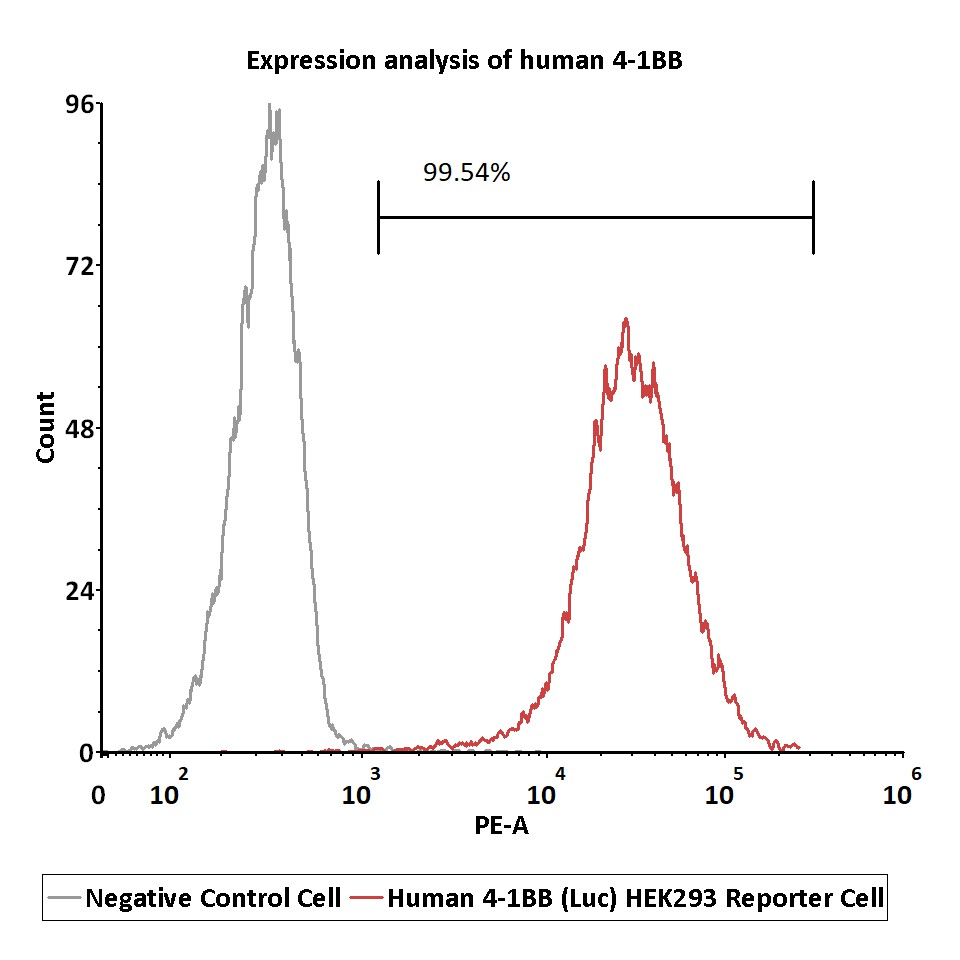- Genetically modified cell lines best reflect MOA (Mechanism of Action)
- Higher activity and larger assay window for robust and reproducible cell-based bioassay
- Comprehensive application data to support assay development and validation
- Full tracible record, stringent quality control and validated cell passage stability
- Parental cell line legally obtained from internationally recognized cell resource bank and commercially licensed
- Global commercial license assistance whenever regulatory filing is required
描述(Description)
The Human 4-1BB (Luc) HEK293 Reporter Cell was engineered to not only express NF-κB signaling response element, but also express the receptor full length human 4-1BB (Gene ID: 3604), which can drive luciferase expressing systems by 4-1BB ligand/ agonist antibody stimulation. In the absence of agonist antibody or 4-1BB ligand, the 4-1BB receptor is not activated and luminescence signal is low. In the presence of agonist antibody or 4-1BB ligand, the 4-1BB pathway-activated luminescence can be detected in a dose-dependent manner. This reporter cell can also be used to test agonist antibody whether in an FcγR-dependent manner to strengthen the agonistic activity
应用说明(Application)
• Screen for ligands or agonist antibodies that can bind and activate 4-1BB

生长特性(Growth Properties)
Adherent
筛选标记(Selection Marker)
Puromycin (2 μg/mL) + Hygromycin (20 μg/mL)
培养基(Complete Growth Medium)
DMEM medium + 10% FBS
冻存液(Freeze Medium)
Serum-free cell cryopreservation medium
装量(Quantity)
1 vial contains at least 5×10^6 cells in 1 mL serum-free cryopreservation medium
存储(Storage)
Frozen in liquid nitrogen.
支原体检测(Mycoplasma Testing)
Negative
无菌检测(Sterility Testing)
Negative
使用说明(Instructions for Use)
See data sheet for detailed culturing and assay protocol.
Receptor Assay

Expression analysis of human 4-1BB on Human 4-1BB (Luc) HEK293 Reporter Cell by FACS.
Cell surface staining was performed on Human 4-1BB (Luc) HEK293 Reporter Cell or negative control cell using PE-labeled anti-human 4-1BB antibody.
Protocol
Application

Agonistic activity analysis of anti-human 4-1BB antibody.
This reporter cell was incubated with serial dilutions of antibodies in the presence of CHO or CHO/CD32b. Urelumab, a strong intrinsic agonistic antibody, can activate 4-1BB signaling independent of CD32b-mediated crosslinking. Utomilumab, a weak agonistic antibody, can activate 4-1BB signaling dependent on CD32b-mediated crosslinking.
Protocol
Signaling Bioassay

Response to Anti-human 4-1BB antibody (RLU).
The Human 4-1BB (Luc) HEK293 Reporter Cell was stimulated with serial dilutions of anti-human 4-1BB antibody. The EC50 was approximately 0.83 μg/mL.
Protocol

Response to Anti-human 4-1BB antibody (FOLD).
The Human 4-1BB (Luc) HEK293 Reporter Cell was stimulated with serial dilutions of Anti-human 4-1BB antibody. The max induction fold was approximately 98.
Protocol
Passage Stability

Passage stability analysis by Signaling Bioassay.
The continuously growing Human 4-1BB (Luc) HEK293 Reporter Cell was stimulated with serial dilutions of Anti-human 4-1BB antibody. Anti-human 4-1BB antibody stimulated response demonstrates passage stabilization (fold induction and EC50) across passage 6-25.
Protocol
如有相关细胞池需求请联系我们
背景(Background)
4-1BB is also known as CD137, tumor necrosis factor receptor superfamily member 9 (TNFRSF9), induced by lymphocyte activation (ILA), is a co-stimulatory molecule of the tumor necrosis factor (TNF) receptor superfamily. CD137 can be expressed by activated T cells, but to a larger extent on CD8 than on CD4 T cells. In addition, CD137 expression is found on dendritic cells, follicular dendritic cells, natural killer cells, granulocytes and cells of blood vessel walls at sites of inflammation. The best characterized activity of CD137 is its costimulatory activity for activated T cells. Crosslinking of CD137 enhances T cell proliferation, IL-2 secretion survival and cytolytic activity. Further, it can enhance immune activity to eliminate tumors in mice. CD137 can enhance activation-induced T cell apoptosis when triggered by engagement of the TCR/CD3 complex. In addition, 4-1BB/4-1BBL co-stimulatory pathway has been shown to augment secondary CTL responses to several viruses, and meanwhile augment anti-tumor immunity. 4-1BB thus is a promising candidate for immunotherapy of human cancer. CD137 has been shown to interact with TRAF2.
Limited Use&License Disclosure
BY USE OF THIS PRODUCT, RESEARCHER AGREES TO BE BOUND BY THE FOLLOWING TERMS OF LIMITED USE OF THIS CELL LINE PRODUCT.
- If the researcher is not willing to accept the terms of limited use of this cell line product, and the product is unused, ACRO will accept return of the unused product.
- Researchers may use this product for research use only, no commercial use is allowed. "Commercial use" means any and all uses of this product and derivatives by a party for profit or other consideration and may include but is not limited to use in: (1) product manufacture; and (2) to provide a service, information or data; and/or resale of the product or its derivatives, whether or not such product or derivatives are resold for use in research.
- This cell line is neither intended for any animal or human therapeutic purposes nor for any direct human in vivo use . You have no right to share, modify, transfer, distribute, sell, sublicense, or otherwise make the cell line available for use to other researchers, laboratories, research institutions, hospitals, universities, or service organizations.
- ACROBIOSYSTEMS MAKES NO WARRANTIES OR REPRESENTATIONS OF ANY KIND, EITHER EXPRESSED OR IMPLIED, WITH RESPECT TO THE SUITABILITY OF THE CELL LINE FOR ANY PARTICULAR USE.
- ACROBIOSYSTEMS ACCEPTS NO LIABILITY IN CONNECTION WITH THE HANDLING OR USE OF THE CELL LINE.
- Modifications of the cell line, transfer to a third party, or commercial use of the cell line may require a separate license and additional fees. Please contact order.cn@acrobiosystems.com for further details.























































 膜杰作
膜杰作 Star Staining
Star Staining












